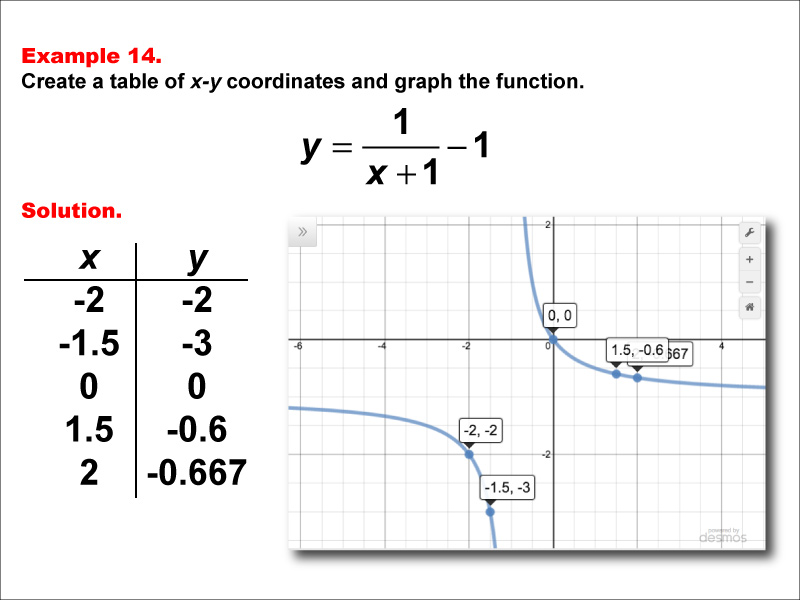
Display Title
Math Example--Rational Concepts--Rational Functions in Tabular and Graph Form: Example 14
Display Title
Math Example--Rational Concepts--Rational Functions in Tabular and Graph Form: Example 14

Topic
Rational Functions
Description
This math example demonstrates the creation of a table of x-y coordinates and the graphing of the function y = 1 / (x + 1) - 1. The image showcases both the table of x-y coordinates and the resulting graph. The table contains specific x-y coordinates: (-2, -2), (-1.5, -3), (0, 0), (1.5, -0.6), (2, -0.667), which are plotted on the graph. This example illustrates how subtracting a constant from a rational function affects its graph.
Rational functions are an important concept in algebra and calculus, representing the ratio of two polynomial functions minus a constant in this case. This collection of examples aids in teaching this topic by providing visual representations of various rational functions, allowing students to observe how alterations in the function impact its graph. By studying multiple examples, students can identify patterns and develop a comprehensive understanding of how constants subtracted from rational functions shift the graph vertically.
The importance of presenting multiple worked-out examples cannot be overstated when it comes to students fully grasping the concept of rational functions and their transformations. Each example builds upon the previous ones, introducing slight variations in the function that result in different graph shapes and positions. This approach enhances students' pattern recognition skills and improves their ability to predict the behavior of rational functions based on their equations.
Teacher's Script: Now, let's look at our fourteenth example: y = 1 / (x + 1) - 1. How does this function compare to our previous example? Notice that we're now subtracting 1 instead of adding it. What effect do you think this will have on the graph? As you observe the graph, you'll see that it's shifted downward by one unit compared to y = 1 / (x + 1). Can you explain why this shift occurs? As we continue exploring more examples, try to predict how different constants added to or subtracted from the function will affect the graphs.
For a complete collection of math examples related to Rational Functions click on this link: Math Examples: Rational Functions in Tables and Graphs Collection.
| Common Core Standards | CCSS.MATH.CONTENT.HSF.IF.C.7, CCSS.MATH.CONTENT.HSF.IF.C.7.D |
|---|---|
| Grade Range | 9 - 12 |
| Curriculum Nodes |
Algebra • Rational Expressions and Functions • Rational Functions and Equations |
| Copyright Year | 2015 |
| Keywords | function, rational functions, graphs of rational functions, rational function tables |